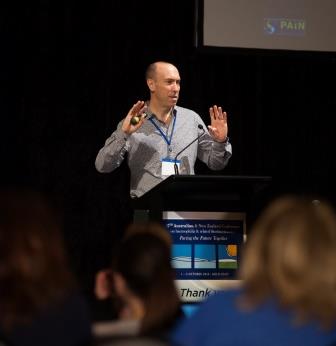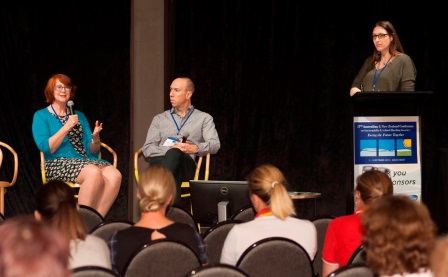Photo right: Carolyn Arnold discussing
a team approach to pain management
CAMERON CRAMEY
Cameron Cramey is the Senior Musculoskeletal Physiotherapist at the Royal Adelaide Hospital
The history of comprehensive care
– Dr Alison Street
The Conference opened with a fantastic overview of the history of comprehensive care from Alison Street. We learnt about the initial development of cryoprecipitate, the early models of comprehensive care in Los Angeles and Oxford in the early 1960s and the emergence of similar models in Australia during the early 1970s. She described the impact of the HIV and hepatitis C epidemics of the late 1970s/early 80s and the impact this had on patients, their families, and treatment centre service provision. With development of virally inactivated plasma derived and then recombinant products through the 1990s the concept of comprehensive care was again back on the radar. This has led us to where we are today – comprehensive care is more than just patient and product. Our current system is perhaps too factor focussed; funding needs to better reflect staffing required to provide optimal long term patient outcomes through active engagement with their medical and allied health team.
Mild haemophilia
Chair: Penny McCarthy
Mild haemophilia across the life span – Penny McCarthy
Mild haemophilia in children – Dr Jamie Price
Personal story – Nathan, SA
Inhibitors, treatment in adults and genetic testing – Dr Simon McRae
People with mild haemophilia have bleeding issues too! I think this was one of the most important take home points from the session on mild haemophilia and inhibitors. It is important that people with mild haemophilia understand their condition and know how to identify and manage a bleed – it only takes a single bleed episode not managed correctly to cause long term issues. Without the experience of managing previous bleeds it’s important to understand that sometimes you may not be able to return to your chosen pursuits as rapidly as you would like. Make sure you seek advice from your treatment centre. We also learnt about the risk of developing inhibitors, how your haematologist may be able to perform genetic testing to better define this risk, and the effect an inhibitor can have on your bleeding phenotype. The effect of this was brilliantly highlighted by an entertaining and informative talk from Nathan. He described his experience of a delayed haemophilia diagnosis and subsequent challenges he faced when he developed an inhibitor which resulted in conversion of his mild haemophilia to a severe bleeding phenotype.
Improving outlooks for pain in haemophilia
Chair: Abi Polus
Humans: The best protectors yet – Prof Lorimer Moseley
Managing pain in haemophilia – A/Prof Carolyn Arnold

Lorimer Moseley explaining 'danger' pain messages
This informative session got us thinking up what ‘pain’ really is and its prevalence within the bleeding disorders community. We learnt that up to 50% of people with haemophilia suffer from chronic pain and it’s more common amongst those with severe haemophilia or a lack of access to effective factor replacement. Joint haemarthrosis and synovitis are a significant cause of much of the ongoing pain, so utilisation of a multi-faceted management approach (rheumatology, orthopaedics, pain physician, appropriate physical activity and exercise prescription, and pain education) is recommended to optimise management of this pain. Lorimer Moseley provided an overview of current pain science understanding. He discussed the concepts of ‘danger’ messages rather than pain being sent from the tissues; and provided multiple examples of how the brain interprets these ‘danger’ messages differently depending on environment, context, mood and a host of other variables. He discussed the concept of ‘helpful protection’ and ‘unhelpful protection’ and how the latter tends to be present in chronic pain. We learnt that by better understanding this process we can get improved control over chronic pain.

The panel discussion about pain
Being active for children, teenagers and young adults
Chair: Wendy Poulsen
Purpose of prophylaxis treating after injury – Dr Chris Barnes
Adventure therapy success in supporting people living with a bleeding disorder – Tim Marchinton
Personal experience – Ben, VIC
Gym training – What are the right exercises for me? – Cameron Cramey
Personal experience – Ty, SA
There’s more to being active than simply playing sport! During this session we heard from a couple of clinicians about the benefits of exercise and physical activity for our general wellbeing and joint health. The pros and cons of weight training were discussed and the importance of having a supervised programme when embarking on a new exercise regime. Appropriate timing of factor therapy for people participating in sporting pursuits was also discussed. However maintaining an active lifestyle can be challenging at times for people with a bleeding disorder, and more importantly than reduced physical capacity, this can lead to reduced self-esteem and social isolation. Tim Marchinton spoke about the role of Adventure Therapy and the psychosocial, emotional and physical benefits for people with bleeding disorders and their families seen through these programs. Ben and Ty both spoke brilliantly about their personal experiences and challenges they faced in balancing their bleeding disorder, physical activity and social pressures.
Getting Older
Chair: Leonie Mudge
Clinical issues – Dr John Rowell
GPs and Men’s Health Checks – Olivia Hollingdrake
Personal experience – Mike, QLD
Falls prevention/keeping mobile – Rebecca Dalzell
With the near normal life expectancy for men with haemophilia, this was a fantastic session with great suggestions for how to optimise health as people age. John Rowell discussed some of the complex medical issues associated with ageing and Olivia Hollingdrake presented a study that she had done at the Queensland Haemophilia Centre, with Beryl Zeissink. This study looked at the amount of knowledge that men with bleeding disorders have about standard recommended men’s health checks, and if they are accessing their local GP to get these done. Results indicated that there was a moderate level of awareness; however there are several tests that people were unaware of. Regular GP contact check-ups were recommended.
Mike from Brisbane gave an inspiring presentation, sharing his personal experience. He encouraged all those who attended to not fear growing older, but to face it with a positive, proactive approach. Rebecca Dalzell was the last presenter and gave an overview of the physical challenges that ageing presents. She discussed joint and muscle changes, osteoporosis, balance and falls prevention. She also presented some results, and a film, from a program she ran in Brisbane called ‘Strong Bloody Men’. This was a 10 week wellness/exercise program, based in the community, specifically designed to address osteoporosis, balance and falls prevention in the haemophilia population. Results showed improvement over the 10 weeks in falls risk, balance and function, and the men reported many positive health benefits. She challenged all those present to consider a bigger picture, more preventative approach to managing those in the more mature years, rather than just focussing on acute issues.
I would like to thank everyone at HFA and the many other people involved in putting together such a high quality conference in what was a lovely venue.
Haemophilia Foundation Australia acknowledges the Traditional Owners and Custodians of Country throughout Australia, the land, waters and community where we walk, live, meet and work. We pay our respects to Elders past and present and extend that respect to all Aboriginal and Torres Strait Islander peoples.
Sign up for the latest news, events and our free National Haemophilia magazine